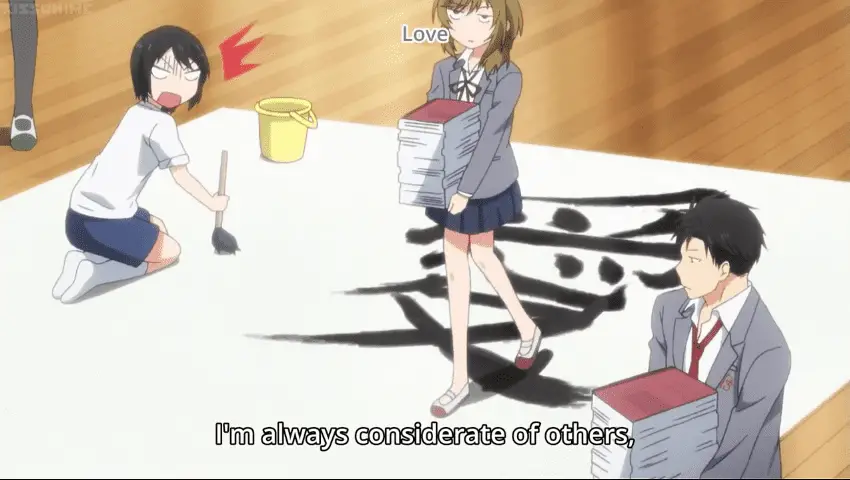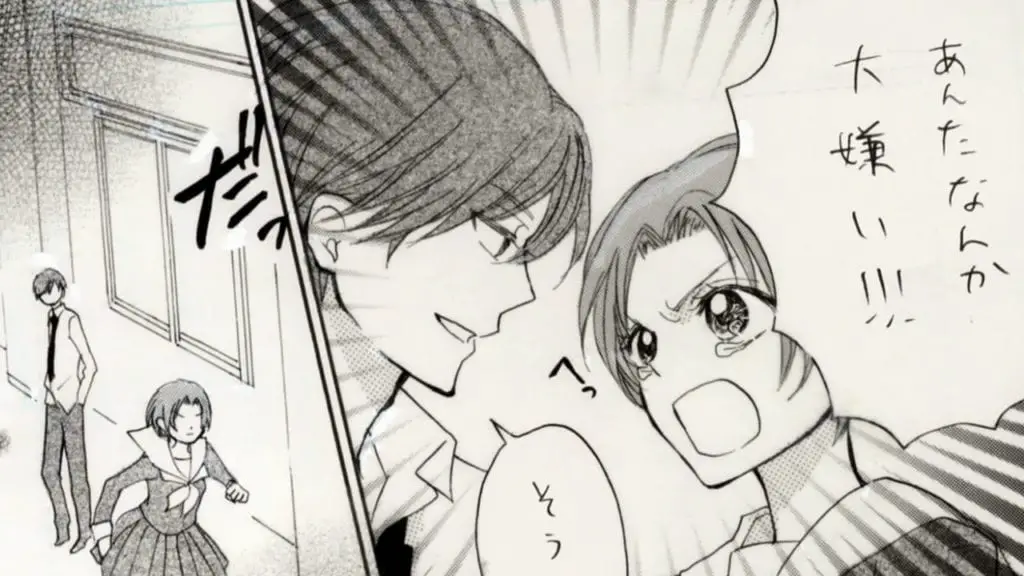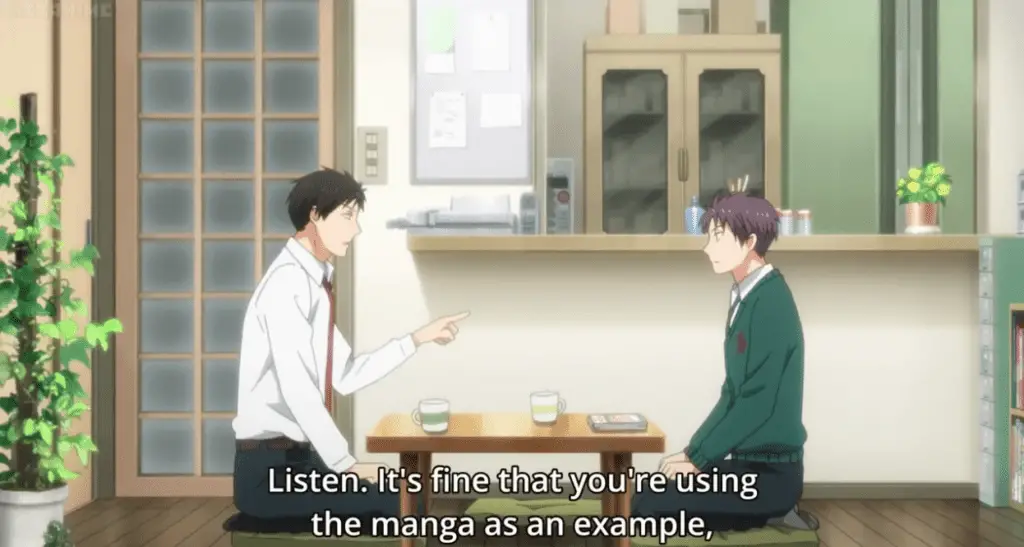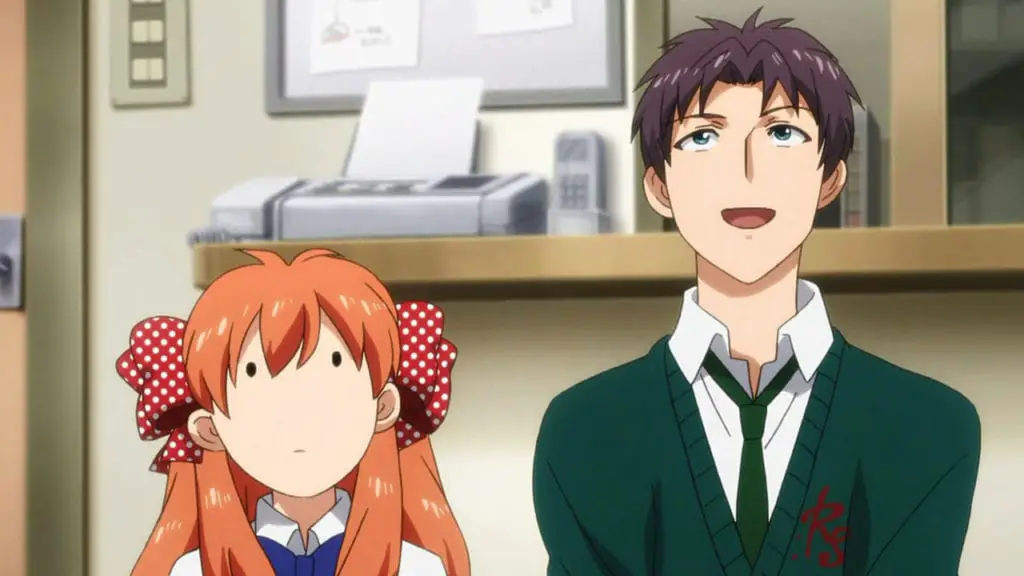With all the hilarious hijinks and fantastically depicted interactions between characters, it is possible to lose sight of the basic premise of this show: a high school boy is a mangaka (manga artist) writing a shoujo manga. Every other aspect of the show—the comedy, the subversion of gender roles, the relationships—undergird this premise. This is the level at which this anime doesn’t just entertain you (though it certainly does), it also says something. It becomes more than entertainment; it becomes a piece of art. To put it bluntly, GSNK is about the distinction and interaction between reality and fiction.
Sakura: Life as a Shoujo Manga
I mentioned in Part 2 that Sakura as a character does not subvert gender roles as much as most of the rest of the cast. While she often plays the part of rational thinker to some of the other character’s more exaggerated personality quirks, the other major facet of her character is her romanticization of life based on her immersion in shoujo manga. She loves shoujo and approaches the world with the expectation that it will conform to shoujo manga tropes, becoming frustrated when the world doesn’t work that way.
This is nowhere more clear than in her approach to people. As an avid reader of shoujo manga, she expects her life to look like a shoujo romance and tries to fit people into shoujo tropes and gender roles. When she discovers that the prince of the school is a girl, she is baffled, but soon takes it in stride. She misclassifies Seo as the ‘helpful friend’ from a shoujo manga and thinks her beautiful voice is what makes her good manga character material.

We see in the final episode that her first impression of Nozaki is that he is a Yakuza (the equivalent of a gang) bad boy who skips school because he’s a rebel. Her discovery that Mikoshiba is the basis for Nozaki’s heroine makes it difficult for her to continue reading “Let’s Fall in Love” because it turns her perception of the world on its head.
As we watch her stumble through helping Nozaki write his manga while nursing a deep crush on him, we also see her start to recognize the gap between her expectations and reality. Comedic misunderstanding combined with the way all of the other characters subvert their expected gender roles forces Sakura to absorb the truth that the world doesn’t work the way it does in fiction.
Her first impression of Nozaki as a hardcore rebel was dead wrong; he’s actually rather romantic and gentle. Males can be insecure and easily embarrassed, and females can be charming and suave with the ladies. Boys can be sensitive and emotional, and girls can be emotionally oblivious and unintentionally hurtful. Romantic scenarios like sharing a bicycle actually don’t translate well into real life. Gestures of affection need not be romantic to be meaningful. Bit by bit her manga-induced worldview is torn down and replaced with a much messier (and much funnier) reality.
Nozaki: Life is (Clearly Not) a Shoujo Manga
If Sakura shows us the struggle of a manga reader to distinguish between shoujo manga and reality, Nozaki gives us the parallel struggle of the manga creator. As a mangaka, almost every interaction he has with others is transformed into a potential scene for his manga. School events, other people’s relationships, even his own friendships are sources of inspiration. He tells Sakura that he first became friends with Mikoshiba so that he could use the latter as character inspiration. His friendships with Seo, Wakamatsu, and Kashima begin as character inspirations as well. Only Sakura seems to not play a role in his manga as a character. Rather, she serves as both the witting and unwitting partner for most of his situational experiments (walking home with a bicycle, sharing an umbrella, bringing bento boxes, etc).
But Nozaki doesn’t directly translate his experience into his manga. While Sakura is trying to fit reality into her shoujo-induced worldview, Nozaki is busy translating that reality into the genre expectations of shoujo manga. Mikoshiba’s insecurity becomes the basis for a female character, Seo’s obliviousness is turned masculine, and Kashima’s charm and charisma are the basis for the male princes in the plays Nozaki writes for Hori. When characters subvert gender roles, Nozaki ‘fixes’ them in his manga, placing characters into their more expected genre and gender stereotypes.

Nevertheless, both Sakura and Nozaki are coming from fundamentally the same place. Neither of them have any real world experience of romance or love, nor do any of their peers. Mikoshiba learning how to talk to girls from playing dating sims is an extreme depiction of all of the characters’ lives: they use fiction as a basis for how to approach the world.
For Nozaki, this can take the form of being so absorbed in his fictional reality, that he fails to see what is happening in his immediate context (see especially, the GSNK DVD specials, episode 4). Actions that are (quite reasonably) interpreted as gestures of affection by Sakura are no more than experiments for manga scenarios, yet he is oblivious to their implications and affects on Sakura. Social interactions are fodder for his manga rather than being valuable for their own sake. He’s stuck in storytelling mode and when we are given his perspective, the lines between reality and the fiction he’s producing are blurred.
Nozaki is not just a purveyor of genre expectations but also a consumer, a fact evident throughout the show. When Mikoshiba asks him to help him prepare for a mixer (episode 4), Nozaki approaches the situation with a list of what to expect based on shoujo tropes.
Earlier in that episode, Nozaki’s repeated failures to succeed at the dating sim Mikoshiba wants him to play stem from his applying shoujo logic to his interactions with the female sims. He projects onto his relationship with Ken-san, perceiving his editor’s age, terseness, and prompt responses as evidence that Ken is the “cool, mature” type (a shoujo trope). When Wakamatsu needs advice for how to deal with Seo, he asks to read Nozaki’s manga for advice. Rather than deter him, Nozaki merely warns Wakamatsu that he needs to be careful which parts of manga he uses as inspiration. The idea that manga should be used as an example for how to deal with real life situations is accepted at face value.

Thus, unlike Sakura, Nozaki is never confronted with the gap between real life and his stories. As the artist, he sees the world as a jumping off point for manga scenarios and never really snaps out of it. While Sakura’s eyes are continually opened to how different real life is from manga, by the end of the series, Nozaki is as oblivious as ever to the profound effect being a mangaka has on his perceptions of himself, his perception of others, and his engagement with real life.
Sakura & Nozaki: Artist and Audience
None of the other characters are unhappy at all with their situation vis-à-vis shoujo manga, nor do they seem to struggle with distinguishing between how life actually works and how it “ought” to work. They have not absorbed the framework of romance manga into their worldview. This is a problem that only Sakura and Nozaki seem to have, our protagonists. It is not unreasonable to posit that this is the underlying theme of the series: the struggle to distinguish between fiction and reality, between how media communicates to us how the world ‘ought’ to work and how the world actually works.
As the Mary Sue points out, Sakura “often acts as the POV character for the audience, reacting with surprise and sweatdrops to the antics of the cast around her as they continue to subvert her idea about how this world should behave.” Sakura shows us ourselves: young, impressionable, saturated with fictional representations of reality with no real life experience to counteract the messaging we’ve absorbed. She represent the audience reading fiction and manga, watching television and anime, and absorbing the genre expectations that it then projects onto life.
Like Sakura, we the audience learn what male and female coded behaviors and traits are by watching and reading fiction as children. When human beings fail to meet our expected gender criteria, we can either react like Sakura and accept them as they are or reject them as aberrations.
Through Sakura, we also get to see the artist and the process of artistic creation because it is her relationship with Nozaki that brings out her struggle to distinguish fiction-based expectations from reality. She gets to see, first hand, that mangas are not a simple translation of reality onto the page. It’s complicated with artistic license (Nozaki’s interpretations of people and events) and bureaucratic nonsense (Maeno-san’s and Ken-san’s demands). She even gets a chance to try and write Nozaki’s manga for him when he gets sick (Episode 6), learning that translating people in characters is complicated and fraught with difficulty because how they perceive the line between reality and fiction is so blurred.

Thus Sakura’s inside look into the production and publication of shoujo manga is a revelation not just for her, but for the audience. Through Sakura we also see that media is not a straightforward representation of reality. As her eyes are opened, so are ours.
The relationship between Sakura and Nozaki also shows us our love affair with artistic expression despite its ignorance of our personal desires. Like Nozaki, producers of fiction and media are often oblivious to the audience’s desires, choosing to rehash and regurgitate the same genre tropes that they’ve absorbed as representative of reality. Nozaki seems ignorant of the significance of what he does when he translates his friends into their more acceptable genre stereotypes. He’s not malicious, he’s just following the norm and doing what is expected of him for the genre of shoujo manga.
Much of the media we consume is the same way. We see women and poc in the same roles over and over again because the creators seem to believe that his is “what people want” or “what sells.” When films like Mad Max: Fury Road and Star Wars: The Force Awakens violate genre expectations by giving us strong, capable women, many people get angry, preferring their expected tropes (and their corresponding version of reality) to a more honest depiction of real life.
In Nozaki, we see that the artist is not necessarily (though they sometimes can be) a cynical, malicious purveyor of tropes who intends to subvert reality to his whims. Nozaki is not only a part of the problem, he’s also a victim of his own genre expectations. While he sees the same world Sakura does, he’s so absorbed by his job as a mangaka that he literally cannot help but translate what he sees into its expected categories in shoujo manga and doesn’t seem to realize that he’s doing it.
Ironically, he also does not realize that as a mangaka who produces shoujo manga, he contributes to Sakura’s ongoing struggle with the world subverting her expectations. Yet in a way reminiscent of Seo and Wakamatsu’s dynamic, he is also a part of the solution. By letting her be a part of his work and giving her an inside look at just how big the gap is between their real life experiences and what he produces in his manga, he inadvertently aids in her journey of self discovery. He is both a purveyor of the status quo and (unintentionally) the one to undermine it.

Conclusion
This is a show about blurring the lines between reality and fiction and the problems that creates. It’s more than just a com with a dash of rom, a high school anime fixated on comedic misunderstanding and subverting gender roles. While these are true descriptions, they’re not the whole. GSNK is fundamentally a story about how manga specifically, and media more generally is produced. It’s about the translation of the real world into fiction and how the end result often contradicts lived experience because of a rigid adherence to genre expectations and gender norms. It also shows us that if we understand what’s happening, we can overcome our tendency to approach the world from the perspective of the fiction we consume.
Sakura’s conclusion in the last episode that she’s “happy with the way things are” epitomizes this journey. While on one level the ending of the show seems to embrace rom-com tropes—the flashback, the will-they-won’t-they kiss, the verbal misunderstanding because of the firework, the protagonist accepting that her love interest does not return her admiration—given how the whole series has been about her struggle to distinguish between reality and fiction, her statement reads as an acceptance of reality as is.
She’s realized that reality is not, in fact, a manga romance and she’s happy with that. The flashback and verbal misunderstanding form a nice bookend to the opening of the series, which began with Nozaki misunderstanding Sakura’s declaration of love. Again, she has declared her love and again, he misunderstands. Only rather than react with frustration and embarrassment, she laughs and moves on. She’s finally embraced reality rather than fiction.
And as the POV for the audience, we too are to embrace reality rather than the status quo depicted in the media. We can definitely enjoy media, despite its flaws, but ultimately we should be happy with the messiness and complexity of life when it does not conform to our expectations. After all, the ‘real life’ of the characters in GSNK is much more entertaining and interesting than what Nozaki translated it into in the pages of his manga.

